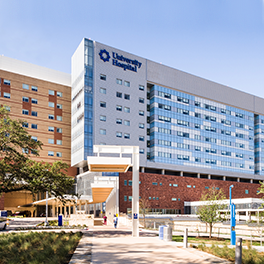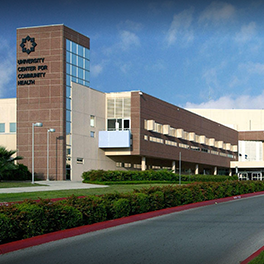We offer physician-supervised hyperbaric oxygen therapy to adult and pediatric patients as a unique advanced treatment option. University Hospital is one of three civilian Texas hospitals where patients can receive emergency care in a hyperbaric chamber.
We also offer this therapy at our Texas Diabetes Institute, where we treat patients for diabetic wound care, including diabetic foot ulcers.
Hyperbaric oxygen therapy (HBOT) exposes the body to pressurized, pure oxygen to aid in the recovery of certain conditions, including persistent wounds, chronic skin or bone infections and carbon monoxide poisoning.
Exposing the body to pure oxygen at a higher pressure – about 2 to 3 times higher than normal atmospheric pressure – helps the body transport more oxygen through your blood to the rest of your body.
What Is a Hyperbaric Chamber?
A hyperbaric chamber essentially is a bed encased in clear tube that allows you to breathe and keeps the pure oxygen contained in the high-pressure environment.
The air we breathe is about 21% oxygen and 78% nitrogen, with the remaining 1% being a mix of other gases. Because open wounds and sores need oxygen to heal, exposing them to 100% oxygen in a hyperbaric chamber can help speed up the process. HBOT removes trapped air bubbles and delivers more oxygen throughout the body.
Conditions Treated in a Hyperbaric Chamber
Hyperbaric chambers can help treat:
- Air or gas embolism
- Arterial insufficiencies
- Blood loss anemia
- Burns
- Compromised skin grafts
- Crush injuries
- Decompression sickness (also called “the bends”)
- Gas gangrene (dying body tissue that forms toxins and releases gas into body)
- Sudden hearing loss (also called idiopathic sudden sensorineural hearing loss)
- Intracranial abscess
- Non-healing wounds like diabetic foot ulcers
- Radiation injuries
- Severe carbon monoxide poisoning
- Severe gangrene
- Severe infections of the bones and skin
- Sudden and unexplained hearing loss
Treating Carbon Monoxide Poisoning
Carbon monoxide is an odorless, colorless and tasteless gas that is produced by burning fuel. When too much carbon dioxide builds up in the blood, a person will experience carbon monoxide poisoning. If untreated, it can result in death. Hyperbaric chambers can treat severe cases of carbon monoxide poisoning and reverse its effects.
Carbon monoxide poisoning is more common during the winter months when people use gas heaters and stoves to heat their homes.
Prevent carbon monoxide poisoning at home by installing carbon monoxide detectors and having gas-fueled appliances inspected by a professional each year.
Advanced Wound Healing
Hyperbaric chambers are proven useful in healing wounds including:
- Diabetic foot ulcers
- Burns
- Bacterial skin infections
- Crush injuries
The pure oxygen will activate your body’s immune cells and begin regenerating skin tissue to heal the wound more quickly.

What to Expect During Treatment
Your provider will let you know how long you will receive HBOT. Depending on your condition, you may spend 90 minutes or up to several hours per visit in the chamber.
When going through HBOT, you will lay on the bed and breathe normally while the pressure is increased. It is common to experience ear popping, like you would on an airplane.
Electronics and personal items are not allowed inside the hyperbaric chamber; however, a TV is placed outside the chamber with sound directed into it so you can have entertainment during your session.
Advanced Care at University Health
University Hospital is the only civilian health care facility in the region to offer emergency hyperbaric chamber treatment. Our expert team of providers can treat emergency and chronic conditions, including wounds and severe carbon monoxide poisoning.
Ask your primary care provider for a referral.
Diving Evaluations
Our physicians at University Hospital and Texas Diabetes Institute also offer examinations for recreational scuba diving and commercial dive training. These include initial certification, return-to-dive clearance and consultation regarding medical conditions that may affect diving safety.




